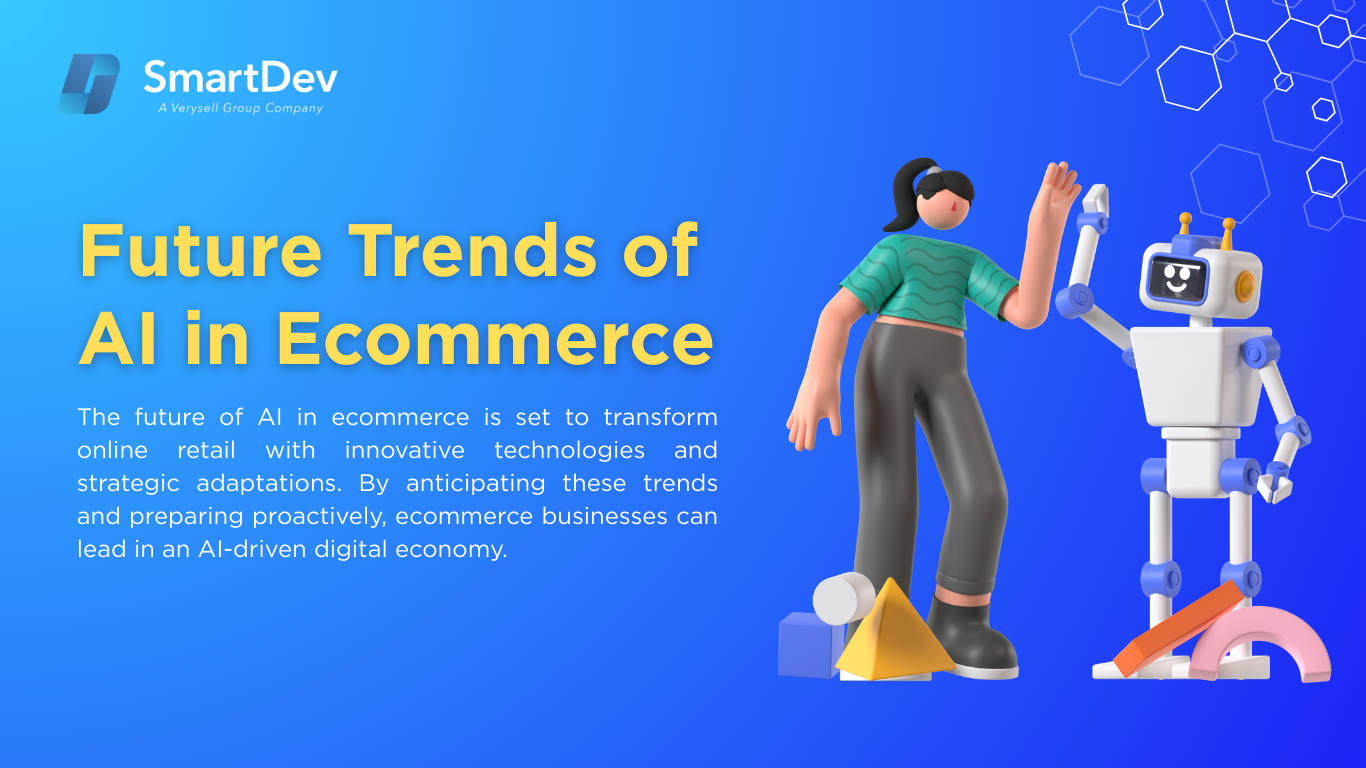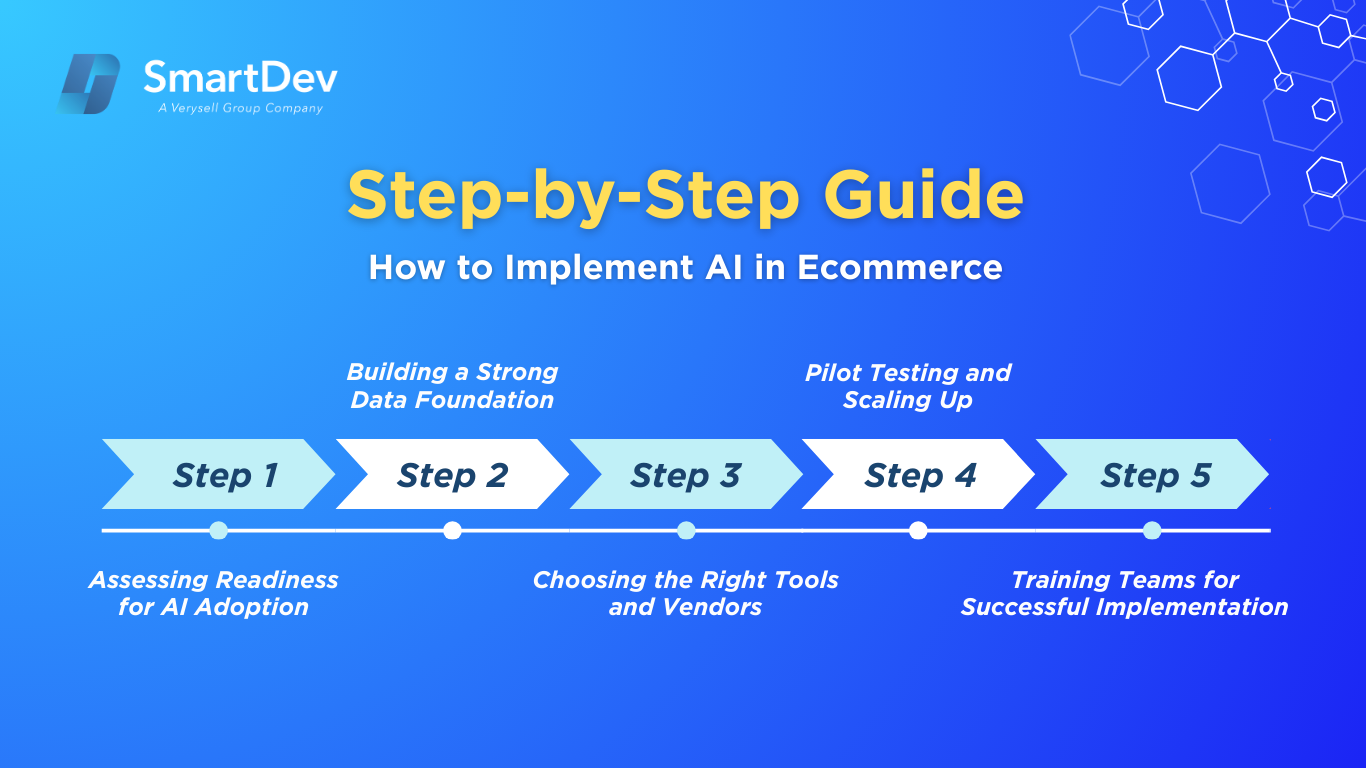Artificial Intelligence (AI) is redefining ecommerce, enabling businesses to deliver personalized experiences and optimize operations. From AI-driven recommendations to automated inventory management, this technology is a catalyst for growth in a competitive digital market. This blog explores AI’s transformative impact on ecommerce, its key benefits, challenges and actionable strategies for retailers aiming to harness its potential.
What is AI and Why Does It Matter in Ecommerce?
Definition of AI and its core technologies
AI refers to systems that simulate human intelligence, enabling machines to learn, reason, and make decisions. According to IBM, AI encompasses technologies like machine learning (ML), natural language processing (NLP), and computer vision, which drive intelligent automation and data-driven insights. ML powers predictive analytics, NLP enables conversational interfaces, and computer vision supports visual search capabilities.
The Growing Role of AI in Transforming Ecommerce
Artificial Intelligence (AI) is increasingly pivotal in transforming the ecommerce landscape, revolutionizing how businesses operate and engage with customers. AI technologies, including machine learning, natural language processing, and computer vision, are integrated into various aspects of ecommerce to enhance personalization, optimize operations, and improve decision-making.
A prime example is AI-powered product recommendation systems, such as those used by Amazon, which analyze customer behavior to suggest products, accounting for 35% of their sales and significantly boosting customer satisfaction. Additionally, AI chatbots provide 24/7 customer support, handling inquiries and guiding customers through the shopping process efficiently.
On the operational side, AI is leveraged for demand forecasting, inventory management, and price optimization, helping businesses reduce costs and enhance efficiency. Looking ahead to 2025, emerging trends like hyper-personalization – where AI tailors shopping experiences to individual users – and the integration of voice and visual search will further innovate ecommerce, delivering seamless and intuitive shopping experiences.
Key Statistics and Trends Highlighting AI Adoption in Ecommerce

Source: McKinsey Global Surveys
The rise of AI in ecommerce is reshaping how online businesses operate, optimize, and grow. With AI powering everything from personalized recommendations to automated customer service, the global AI ecommerce market is projected to reach $8.65 billion by 2025, climbing to $22.6 billion by 2032, with some estimates going as high as $45.72 billion. These numbers reflect the growing reliance on AI-powered ecommerce solutions to stay competitive in a fast-changing digital marketplace.
According to McKinsey, 78% of companies have adopted AI in at least one business function and 71% report frequent use of generative AI. In the retail sector, 53% of large enterprises (with over $500 million in annual revenue) are leveraging AI for real-time analytics and operations. Despite strong interest, only 40% of ecommerce businesses currently apply AI in meaningful, scalable ways – highlighting the untapped potential in the sector.
In short, AI in ecommerce is no longer just a trend – it’s a strategic imperative. To remain competitive, online retailers must move beyond experimentation. Now is the time to build a clear AI roadmap, invest in AI-ready infrastructure, and start implementing AI-driven features that enhance the customer journey and drive growth.
Business Benefits of AI in Ecommerce
1. Maximizing Operational Efficiency
AI in ecommerce streamlines operations by automating routine tasks like inventory tracking, pricing adjustments, and warehouse management, cutting costs and enhancing scalability. Machine learning analyzes customer data to uncover upselling opportunities, while robotic automation speeds up warehouse tasks. AI can also be used to build stronger relationships with customers, provide customer service 24/7, respond quickly to customer queries, and provide personalized recommendations based on their needs and interests.
2. Improving Decision-Making Quality and Accuracy
AI enhances ecommerce decision-making by providing precise, data-driven insights. Algorithms process large customer datasets to identify trends, guiding marketing and product strategies. AI also strengthens fraud detection and compliance efforts, reducing risks. By eliminating error-prone manual analysis, AI in ecommerce ensures reliable, strategic decisions for sustained success.
3. Streamlining Processes
AI optimizes ecommerce processes through automation, increasing efficiency and competitiveness. From managing inventory to refining pricing, AI minimizes manual efforts and operational expenses. AI-driven analytics also enhance marketing by pinpointing high-value opportunities. This streamlined approach enables businesses to operate leaner and adapt swiftly to market changes.
4. Making Conversations
AI in ecommerce improves customer interactions with AI-powered chatbots that offer 24/7, personalized support. Using natural language processing, chatbots handle inquiries, suggest products, and facilitate upselling, boosting efficiency and satisfaction. By automating customer service, AI allows ecommerce businesses to allocate human resources to strategic priorities while ensuring seamless engagement.
5. Increase Loyalty and Retention
AI fosters customer loyalty and retention in ecommerce by delivering personalized experiences that resonate with shoppers. AI tools craft tailored offers based on data analysis, while chatbots resolve issues promptly, building trust. These efforts convert one-time buyers into loyal customers, enhancing brand reputation and driving traffic through positive engagement, making AI in ecommerce vital for long-term growth.
Challenges Facing AI Adoption in Ecommerce
While AI transforms ecommerce with personalized experiences and operational efficiencies, several challenges hinder its adoption. From data quality issues to integration complexities, these obstacles require strategic solutions to ensure successful AI implementation in ecommerce. Below, we explore the key challenge:
1. Data Scarcity, Messy and Unclear Data Sources
AI in ecommerce relies on vast, high-quality datasets to power machine learning models for tasks like personalization and forecasting. However, many businesses struggle with scarce, disorganized, or unclear data, leading to inaccurate AI outputs such as irrelevant product recommendations or flawed inventory predictions.
Strict privacy regulations, like GDPR, further limit data collection, complicating efforts to build robust datasets (GDPR). Ecommerce retailers must prioritize data management systems and regular audits to ensure clean, compliant data that drives reliable AI performance.
2. High Initial Costs
Implementing AI in ecommerce demands substantial upfront investments in software, hardware, and skilled talent, posing a barrier, especially for small and medium-sized enterprises (SMEs). Costs can range from thousands to millions, depending on the complexity, often deterring adoption despite long-term benefits like increased revenue.
3. Hallucinations and Biases
AI systems can produce “hallucinations” – incorrect outputs – or reflect biases from training data, undermining trust in ecommerce applications. Inaccurate product details or biased recommendations can alienate customers and harm brand reputation, with studies noting hallucinations in up to 29.9% of AI outputs. Regular audits, diverse datasets and techniques are essential to ensure accurate, fair AI results in ecommerce.
4. Uncertainty in Terms of Regulations
The rapidly evolving regulatory landscape for AI, including GDPR and CCPA, creates uncertainty for ecommerce businesses, complicating compliance efforts. Non-compliance risks significant fines and reputational damage, particularly for global retailers navigating diverse legal frameworks. Staying informed, implementing robust data protection measures, and consulting legal experts are critical to align AI adoption with regulatory requirements while maintaining customer trust.
5. Integration with Existing Systems
Integrating AI with legacy ecommerce systems is a complex challenge, as outdated platforms often lack compatibility with modern AI technologies, requiring costly and time-consuming IT overhauls.
This can disrupt operations and delay AI benefits, especially for larger enterprises with entrenched systems. Flexible AI tools with robust APIs and a phased integration approach can minimize disruptions, ensuring a smoother transition to AI-driven ecommerce solutions.
Specific Applications of AI in Ecommerce
1. Personalized Product Recommendations
Personalized product recommendations leverage AI, particularly machine learning, to analyze customer data such as browsing history, purchase patterns, and preferences to deliver tailored product suggestions. This application of AI in ecommerce enhances the shopping experience by presenting relevant items at optimal moments, increasing conversion rates and fostering customer loyalty.
Amazon’s AI-driven recommendation engine is a benchmark for this application, accounting for 35% of its total sales by suggesting products based on user behavior and preferences. This success stems from Amazon’s sophisticated machine learning models that process vast datasets in real-time, delivering hyper-relevant suggestions, such as “Customers who bought this also bought” prompts. The impact is twofold: it drives immediate sales by reducing search friction and builds long-term loyalty by creating a personalized shopping journey, setting a high standard for AI in ecommerce personalization.
2. AI-Powered Customer Support Chatbots
Driven by natural language processing (NLP), AI-powered chatbots offer 24/7 customer support in ecommerce, handling inquiries, returns and personalized product recommendations. This application of AI in ecommerce reduces response time, cuts operational costs, and improves customer satisfaction by managing high interaction volumes efficiently. Chatbots also boost sales through upselling during conversations, making them a valuable tool for both service and revenue growth.
Sephora’s AI chatbot, integrated into its mobile app, delivers personalized beauty advice, product suggestions, and virtual try-ons, leading to an 11% increase in conversions. Its NLP capabilities enable it to understand complex queries and respond naturally, easing pressure on support staff while guiding customers to the right products – showcasing how AI in ecommerce improves both experience and outcomes.
3. Demand Forecasting and Price Optimization
Dynamic pricing optimization uses AI – especially predictive analytics and machine learning to adjust product prices in real time based on demand, competitor pricing, and customer behavior. This application of AI in ecommerce helps maximize profit margins while staying competitive. By forecasting trends and external factors like seasonality, AI enables smarter pricing strategies that balance growth and customer trust.
Walmart’s AI-driven pricing adjusts prices across both online and physical stores, improving profit margins by 15%. By analyzing competitor data, demand, and inventory levels, Walmart stays competitive while boosting revenue – showcasing how AI in ecommerce drives profitability through smart pricing.
Examples of AI in Ecommerce
1. H&M: Revolutionizing Fashion Retail with Virtual Fitting Rooms and Digital Avatars

H&M Virtual Fitting Rooms
H&M, a global fashion retail leader, faced the challenge of improving the in-store and online shopping experience to meet evolving customer expectations. Traditional fitting rooms were often inconvenient, with issues like limited space and long queues discouraging purchases. Additionally, ensuring accurate fit and reducing size-related returns were critical to enhancing customer satisfaction and operational efficiency in a competitive fast-fashion market.
To address these challenges, H&M partnered with NeXR Technologies through its Berlin-based innovation lab, H&Mbeyond, to implement virtual fitting rooms powered by AI and 3D scanning technology. In select stores in Germany and Thailand, customers could use the Fusion III body scanner to create a personal digital avatar with exact body measurements.
The AvatarCloud Fashion app allowed users to try on up to 30 apparel items from new collections virtually, both in-store and at home, using augmented reality to visualize fit and style. The AI system also provided size recommendations based on the avatar’s measurements, streamlining the decision-making process and enhancing personalization.
The virtual fitting rooms have significantly improved H&M’s shopping experience. Customers reported greater confidence in their purchase decisions, as the digital avatars ensured a more accurate representation of fit, reducing the need for physical try-ons. The technology led to a noticeable decrease in size-related returns, contributing to greater sustainability by minimizing waste. The innovative approach also attracted tech-savvy shoppers, boosting engagement and reinforcing H&M’s position as a forward-thinking retailer
2. iParts: Boosting Conversions with AI Marketing
iParts, a Polish e-commerce company specializing in automotive parts, faced difficulties in recovering lost sales from abandoned carts and engaging customers effectively through email campaigns. The challenge was to increase open rates and conversions for promotional and seasonal marketing efforts, particularly for customers who left items in their carts, in a highly competitive market.
To overcome these hurdles, iParts partnered with GetResponse to implement AI-driven email marketing automation. The solution focused on abandoned cart recovery, using AI to analyze customer behavior and send personalized, timely emails to re-engage users. These emails were tailored based on user preferences and past interactions, with dynamic content to highlight relevant products and offers. The AI system also optimized send times and subject lines to maximize open rates, ensuring campaigns were both effective and efficient.
The AI-driven email campaigns delivered impressive results. iParts achieved a 30% increase in open rates for abandoned cart emails, with 20% of recipients completing their purchases. These improvements boosted overall conversion rates and revenue, demonstrating the power of AI in targeted e-commerce marketing. The success has enabled iParts to strengthen its market position and enhance customer retention.
3. eBay: Enhancing Search and Discovery
eBay, a leading consumer-to-consumer e-commerce platform, struggled to understand user intent for accurate search results and to provide personalized recommendations to drive purchases. These challenges were critical to improving user experience and increasing sales.
To overcome these hurdles, eBay implemented AI-driven solutions focused on search and personalization. Its search system uses natural language processing to analyze queries, delivering more relevant results. AI-powered recommendations analyze browsing history, search patterns, and purchase data to suggest tailored products. Additionally, an image search feature leverages visual recognition technology, allowing users to upload photos and find similar items.
These solutions have improved search accuracy, increased user satisfaction, and boosted conversion rates, leading to higher sales. eBay’s AI-driven approach to product discovery continues to empower users, reinforcing its position in the C2C market.
4. Nestlé: Personalizing Nutrition in Consumer Packaged Goods
Nestlé, a global leader in consumer packaged goods, faced the challenge of delivering personalized nutrition solutions through its e-commerce platforms to meet health-conscious consumer demands. Traditional approaches relied on broad trends, making it difficult to address individual dietary needs like allergies or health goals, while scaling personalization across diverse products remained complex.
Nestlé integrated AI into its e-commerce strategy with platforms like Natra, using machine learning to analyze dietary habits, biometrics, and lifestyle data. This enabled tailored product recommendations for supplements and meal kits, integrated into direct-to-consumer channels. AI-driven recipe tools suggested ingredient substitutions based on health preferences, enhancing the online shopping experience with personalized nutrition options.
Nestlé’s AI-driven e-commerce approach boosted engagement, with personalized recommendations driving repeat purchases and subscription growth. Customer satisfaction and brand loyalty increased, strengthening Nestlé’s position in the health-focused e-commerce market and aligning with consumer demand for tailored nutrition.
5. SmartDev: Building a Trusted Luxury Marketplace
At SmartDev, we’ve successfully delivered multiple AI in ecommerce solutions that boost engagement, streamline operations, and drive revenue. One standout project is a blockchain-powered luxury marketplace, where we combined AI with blockchain to enhance personalization, trust, and efficiency.
The client needed a secure ecommerce platform for luxury goods, using blockchain to verify authenticity and prevent counterfeits. They also aimed to create a community-driven space with gamification to increase loyalty.
SmartDev developed a blockchain-enabled marketplace with AI-powered product recommendations and personalized vendor storefronts. We integrated an AI trust system that rewarded user engagement and supported blockchain-based authentication.
The platform ensures secure, authentic transactions and fosters a loyal community through an AI-driven engagement system. Personalized storefronts and services like authentication and repair deliver a seamless, trusted ecommerce experience.
Read More about Our Case Study
6. Innovative AI Solutions
Emerging AI technologies are reshaping ecommerce by introducing advanced capabilities that streamline operations and elevate customer experiences. Generative AI creates dynamic content, such as personalized product descriptions and marketing visuals, reducing content creation time while boosting SEO and engagement. Computer vision powers visual search and augmented reality (AR), enabling customers to find products via images or virtually try on items like visual search can improve product discovery by 30%.
These solutions transform ecommerce operations by automating tasks, enhancing personalization, and driving sustainability, ensuring businesses remain agile and competitive in a rapidly evolving market.
AI-Driven Innovations Transforming Ecommerce
1. Emerging Technologies in AI for Ecommerce
Generative AI is revolutionizing ecommerce by automating content creation and design processes. It generates product descriptions, personalized marketing copy, and even visual assets like banners, saving time and ensuring consistency. For instance, AI tools can craft SEO-optimized product listings tailored to customer preferences, boosting engagement and conversions. However, businesses must monitor outputs to avoid inaccuracies and maintain brand voice.
Computer vision enables ecommerce platforms to analyze visual data, powering features like visual search and augmented reality (AR). Customers can upload images to find similar products or virtually try on items, enhancing the shopping experience. This technology also improves inventory management by automating visual inspections, reducing errors and streamlining operations
2. AI’s Role in Sustainability Efforts
AI in ecommerce drives sustainability by using predictive analytics to optimize inventory and minimize waste. By forecasting demand accurately, businesses avoid overstocking, reducing unsold goods that contribute to landfill waste. This aligns with consumer demand for eco-friendly practices, enhancing brand reputation.
AI-powered smart systems optimize energy usage in ecommerce operations, such as warehouses and logistics. Machine learning algorithms analyze energy patterns to reduce consumption during peak times, lowering carbon footprints and operational costs. These efforts support sustainable ecommerce practices while maintaining efficiency.
How to Implement AI in Ecommerce
Successfully integrating AI in ecommerce requires a strategic approach, from assessing readiness to training teams. Below, we outline the key steps to implement AI effectively, ensuring ecommerce businesses maximize its benefits while minimizing disruptions.
 1. Assessing Readiness for AI Adoption
1. Assessing Readiness for AI Adoption
Ecommerce businesses must evaluate their readiness for AI by identifying areas where AI can add value, such as personalization, customer support, or inventory management. Conducting a gap analysis helps pinpoint operational inefficiencies and data capabilities, ensuring AI aligns with business goals. This step prevents costly missteps and prioritizes high-impact AI applications.
2. Building a Strong Data Foundation
AI in ecommerce thrives on high-quality data, making data collection, cleaning, and management critical. Businesses should consolidate customer, sales, and operational data into a unified system, using tools like customer data platforms (CDPs) to ensure accuracy and compliance with regulations. A robust data foundation enables reliable AI outputs, from recommendations to forecasting.
3. Choosing the Right Tools and Vendors
Selecting AI platforms tailored to ecommerce needs is essential for successful implementation. Businesses should evaluate vendors based on scalability, ease of integration, and industry-specific features, such as Shopify’s AI tools for inventory or Salesforce’s AI for marketing. Partnering with reputable vendors ensures long-term support and alignment with ecommerce objectives.
4. Pilot Testing and Scaling Up
Before full AI deployment, ecommerce businesses should run small-scale pilot projects to test performance and identify issues. For example, piloting an AI chatbot can reveal integration challenges without risking operations. Successful pilots can then be scaled, leveraging insights to optimize full implementation and minimize disruptions.
5. Training Teams for Successful Implementation
Upskilling employees to work with AI technologies is crucial for seamless adoption. Training programs should focus on understanding AI tools, interpreting outputs, and collaborating with AI systems. This empowers teams to leverage AI effectively, ensuring ecommerce operations remain agile and competitive.
Measuring the ROI of AI in Ecommerce
As AI transforms eCommerce, measuring its ROI is crucial for businesses to validate their investments. By tracking key metrics such as sales growth, customer acquisition, and efficiency, companies can easily assess AI’s impact on revenue and cost savings.
This section provides practical insights to help eCommerce leaders unlock AI’s full potential for sustained success.
1. Key Metrics to Track Success
Tracking the right metrics is critical to assess AI’s effectiveness in ecommerce. Productivity improvements include enhanced sales from AI-driven personalization, such as tailored product recommendations that boost conversion rates, and faster customer service via chatbots, which reduce response times and increase satisfaction.
Cost savings through automation are equally vital, encompassing reduced expenses from streamlined inventory management, fraud detection, and logistics optimization. For instance, automating repetitive tasks can lower operational costs significantly, allowing reinvestment into growth initiatives. Additional metrics like customer retention rates, average order value, and time-to-market for new products provide a holistic view of AI’s contribution, enabling businesses to fine-tune implementations for maximum ROI.
2. Case Studies Demonstrating ROI
AI in ecommerce delivers transformative ROI, as evidenced by leading brands leveraging innovative applications. Amazon harnesses its AI-driven recommendation engine to personalize product suggestions, driving 35% of its total sales by aligning offerings with customer preferences, while AI-optimized logistics slash delivery costs, showcasing scalability and efficiency. Alibaba employs AI for smart logistics and demand forecasting, cutting vehicle usage by 10% and travel distances by 30%, which translates to significant cost savings and a reduced carbon footprint, reinforcing sustainability in ecommerce operations.
iParts, a Polish auto parts retailer, adopted AI-powered email marketing automation with GetResponse, achieving a 30% increase in abandoned cart email open rates and converting 20% of recipients into buyers, boosting revenue and customer engagement. These case studies highlight how AI in ecommerce fuels revenue growth, cost efficiencies, and enhanced customer experiences across global and niche markets.
3. Common Pitfalls and How to Avoid Them
Measuring AI’s ROI in ecommerce can falter due to several pitfalls. Expecting immediate results often leads to misjudgments, as AI requires time to optimize and scale; setting phased, realistic KPIs mitigates this. Poor data quality can distort metrics, such as inaccurate sales forecasts, undermining ROI calculations; robust data governance ensures reliability.
Misaligned AI initiatives that don’t address core business needs dilute impact; a thorough needs assessment aligns AI with strategic goals. Additionally, overlooking long-term benefits, like customer lifetime value gains, can undervalue AI’s impact. By prioritizing data integrity, strategic alignment, and long-term metrics, ecommerce businesses can accurately measure and maximize AI’s ROI.
Future Trends of AI in Ecommerce
The future of AI in ecommerce is set to transform online retail with innovative technologies and strategic adaptations. By anticipating these trends and preparing proactively, ecommerce businesses can lead in an AI-driven digital economy.

1. Predictions for the Next Decade
Over the next decade, AI in ecommerce will drive hyper-personalization, voice commerce, and autonomous operations. Generative AI will create dynamic, customer-specific content, such as personalized product videos, boosting engagement and conversions. Voice assistants are projected to handle 50% of searches by 2030, enabling seamless conversational shopping.
Computer vision will enhance visual search and augmented reality, offering immersive experiences, while AI-driven predictive analytics will optimize autonomous supply chains, reducing delivery times by 25% through predictive analytics, real time tracking and automation. Sustainability-focused AI will minimize waste and energy use, aligning with consumer demand for eco-friendly practices. These trends will redefine ecommerce, emphasizing convenience, efficiency, and sustainability.
2. How Businesses Can Stay Ahead of the Curve
To lead in the AI-driven ecommerce future, businesses must act strategically. Investing in scalable AI platforms ensures adaptability to emerging technologies, while continuous employee training fosters expertise in AI tools, enhancing innovation. Partnering with specialized AI vendors tailored to ecommerce needs provides access to cutting-edge solutions.
Ethical AI practices, including compliance with data privacy regulations like GDPR, build customer trust and mitigate legal risks. Regularly monitoring industry trends and experimenting with pilot projects, such as AI-driven voice commerce, allows businesses to stay agile. By embracing these strategies, ecommerce retailers can harness AI’s potential to maintain a competitive edge and deliver exceptional customer experiences.
Conclusion
1. Summary of Key Takeaways on AI Use Cases in Ecommerce
AI in ecommerce delivers unparalleled benefits, from personalized product recommendations and AI-powered chatbots to dynamic pricing and predictive analytics, enhancing customer experiences and operational efficiency. Emerging technologies, such as generative AI and computer vision, further revolutionize content creation and visual search, while sustainability-focused AI reduces waste and energy use.
Despite challenges like data quality and high costs, strategic implementation – through robust data foundations, pilot testing, and team training – maximizes ROI. Future trends, including voice commerce and autonomous supply chains, promise to redefine ecommerce, emphasizing convenience and eco-conscious practices. These use cases highlight AI’s transformative potential, making it a cornerstone for ecommerce success.
2. Moving Forward: A Path to Progress
In eCommerce, AI is the engine behind smarter recommendations, better customer journeys, and higher conversion rates. Whether you’re optimizing search, automating support, or personalizing experiences—AI gives you the edge. Start with the right foundation. Align your data, identify high-impact opportunities, and scale with trusted AI expertise.
At SmartDev, we build custom AI tools for eCommerce—product recommendation engines, dynamic pricing models, predictive demand systems, and more. We help you move faster, sell smarter, and win bigger. Ready to power your next stage of growth? Let’s build it together.












